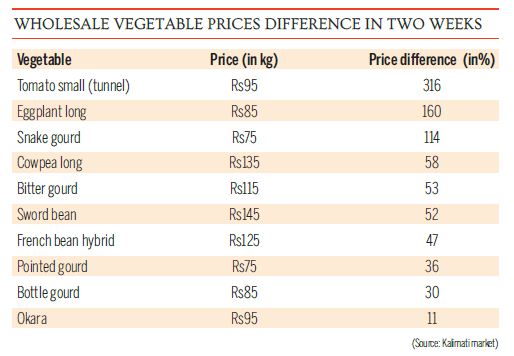Money
Homemakers become stingy as veggie prices surge
Vegetable prices have jumped three-fold in two weeks in Kathmandu Valley on reduced deliveries.
Krishana Prasain
Homemaker Poonam Lamsal of Dhapasi gets frustrated whenever she goes to the market to buy vegetables.
“Everything has become so expensive,” she says. “Vegetable prices have gone so high I am having a hard time managing my kitchen expenses.”
She said she paid Rs200 for a kg of beans and Rs150 for a kg of okra. “We have to buy vegetables every day and I can't understand why prices increase so fast.”
Lamsal said she had to cut down to one vegetable side dish from two because she simply could not afford to pay so much.
Vegetable prices have jumped three-fold in two weeks in Kathmandu Valley on reduced deliveries as farmers have turned their attention to transplanting paddy.
While vegetable growers say they don’t get fair prices for their produce, consumers complain they are being overcharged. High shipping costs and multiple layers of middlemen who each take a fat cut make vegetables pricey by the time they reach consumers' kitchens, insiders say.
Traders say landslides have disrupted transportation, and as a consequence, fewer vegetable shipments are reaching the market, pushing up prices.
Higher prices have come as a double whammy to consumers already struggling to manage household finances due to slowed economic growth. Experts say that the current inflation pattern is highly regressive, affecting the poorest households the most.
Officials expect Nepal’s annual economic growth rate to slow to 1.86 percent this fiscal year ending mid-July. The sluggish growth has raised concerns about household incomes going down sharply.
Traders say prices will likely remain on the high side until the next harvest which is about three months away. Normally, vegetable prices remain high until the Dashain festival in October as it is the paddy growing season.
The monsoon ends by the third week of September. Farms in the southern Tarai plains are currently covered with paddy.
There are few vegetables that cost less than Rs100 per kg, sellers say.
The daily price list published by the Kalimati Fruit and Vegetable Market Development Board is the most followed index in the country. It shows that seasonal vegetables like eggplant, cowpea, French bean, sword bean, bitter gourd, pointed gourd, snake gourd, sponge gourd, squash, okra, mustard leaf, mushroom and asparagus have become dearer in the past two weeks.
The wholesale price of tomato (small) has soared by 316.67 percent reaching Rs40 per kg on Sunday. Eggplant (long) increased by 160 percent to Rs85 per kg, while eggplant (small) increased by 72.73 percent to Rs95 per kg.
The price of cowpea (long) swelled by 58.82 percent to Rs135 per kg in two weeks.
With regard to retail prices, black-eyed beans cost Rs200 per kg, cauliflower Rs125 per kg, green pumpkin Rs95 per kg, sponge gourd Rs120 per kg, bitter gourd Rs125 per kg and okra Rs150 per kg.
“Normally, vegetable production declines when the monsoon is in full force,” said Binay Shrestha, information officer at the Kalimati market. “Moreover, supply is disrupted due to floods and landslides,” he said.
Vegetables are perishable items and they rot very fast in the hot temperatures of the summer if transportation is delayed for some reason.
Nepali farmers begin transplanting paddy with the advent of the monsoon, and transplanting had been completed on 26 percent of the 1.36 million hectares of paddy fields in the country as of last Thursday, according to the Agriculture Ministry
The Kalimati market, the largest fresh produce bazaar in Nepal, received 795 tonnes of vegetables on Saturday against 723 tonnes two weeks ago, said Shrestha.
Kathmandu Valley depends on neighbouring districts like Dhading, Kabhre and Makwanpur for its vegetable requirement during the monsoon, as supply from the southern Tarai plains drops sharply.
Traders say that potatoes and onions are imported from India. According to agro experts, Nepal was self-sufficient in potato production until a few years ago, but imports have been swelling of late.
Nepal imported potatoes worth Rs6.32 billion in fiscal 2019-20, as per the statistics of the Customs Department. Imports increased to Rs7.40 billion in the first 11 months of the current fiscal year.
Costly vegetables are straining household budgets. According to economists, low-income households in Nepal typically spend more than a third of their overall budget on food.
The cost of staples that make up most of a poor household’s expenditure on food has risen sharply. Reports say that poor households have been buying less food, leading to lower nutritional intakes, particularly among the most vulnerable families.





 20.12°C Kathmandu
20.12°C Kathmandu















